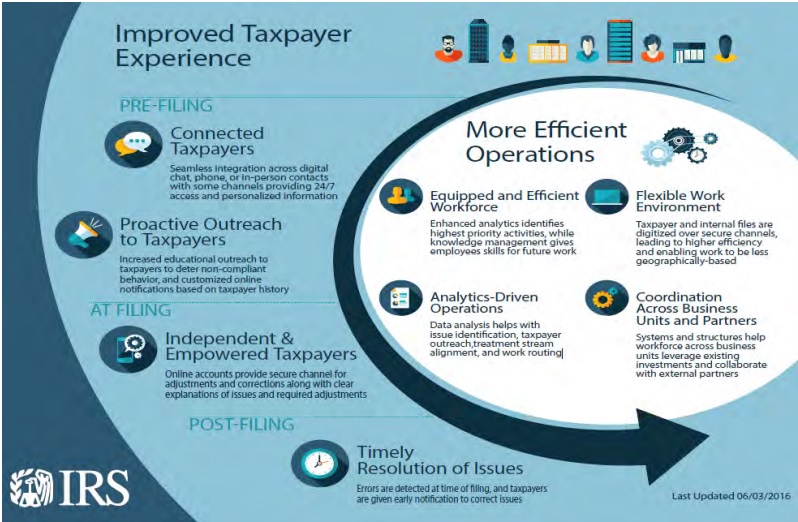The Internal Revenue Service and its in-house watchdog the National Taxpayer Advocate’s office are debating the future of the agency and how that will affect us and our filings in the coming years.
The IRS is working on what it calls its Future State plan, an outline of agency activities in five years and beyond. One of the plan’s central components is online taxpayer accounts. These accounts, says the IRS, will substantially reduce the number of telephone calls and visits it receives every year from filers.

The world is changing and taxpayer expectations are changing. To look at the future in a more comprehensive way, the IRS is working on a Future State for tax administration, and a critical part of that is working with the wider tax community on this effort. This is an evolving and long-term effort, and we will share updates as more information becomes available.
The IRS needs to take advantage of the latest technology to move the entire taxpayer experience to a new level. And it needs to be done in a way that meets the needs of taxpayers and the tax community in an efficient and effective manner while respecting taxpayer rights. At the same time, taxpayers may still need one-on-one assistance by phone or in-person.
All of these efforts touch many different parts of the agency, and they have been described as the IRS Future State initiative.
The IRS Future State efforts continue to evolve, and getting feedback from a wide variety of voices will be a critical part of these efforts to help improve tax administration in a rapidly evolving world.
Six strategic themes
To guide how we’re going to get there, we established six strategic themes and a focus area of strengthening cybersecurity and eliminating identity theft. The themes are:
- Facilitate voluntary compliance by empowering taxpayers with secure innovative tools and support
- Understand non-compliant taxpayer behavior and develop approaches to deter and change it
- Leverage and collaborate with external stakeholders
- Cultivate a well-equipped, diverse, skilled and flexible workforce
- Select highest value work using data analytics and a robust feedback loop
- Drive more agility, efficiency, and effectiveness in IRS operations
You can read more about the IRS Future State on IRS.gov
Here are the details of the Future State Plan
IRS Future State PlansPart of the reason for turning to more taxpayer self-sufficiency is that in general, we are becoming more accustomed to using online services in all aspects of our lives. But the real reason for the change is money. IRS Commissioner John Koskinen, during a February appearance before the Senate Finance Committee, said:
“Within our tight budget constraints, the IRS has also continued to analyze and develop plans for improving how the agency can fulfill its mission in the future, especially in delivering service to taxpayers and, along with that, maintaining a robust compliance program. … We need to be, and are, looking forward to a new, improved way of doing business that involves a more robust online taxpayer experience. This is driven, in part, by business imperatives; when it costs between $40 and $60 to interact with a taxpayer in person and less than $1 to interact online, we must reexamine how we provide the best possible taxpayer experience, in response to taxpayer expectations and demands. …
Even with the improvements we have made and continue to make, we are at the point where we believe the taxpayer experience needs to be taken to a new level. Our goal is to increase the availability and quality of self-service interactions, which will give taxpayers confidence in knowing they can take care of their tax obligations in a fast, secure, and consistent manner. The idea is that taxpayers would have an account at the IRS where they, or their preparers, could log in securely, get all the information about their account, and interact with the IRS as needed. Most things that taxpayers need to do to fulfill their obligations could be done virtually, and there would be much less need for in-person help, either by waiting in line at an IRS assistance center or calling the IRS.”
“The IRS receives more than 100 million taxpayer calls and five million taxpayer visits each year, so a significant reduction in these services will leave taxpayer needs unmet and force millions of taxpayers to pay for help, and generate additional taxpayer frustration with the IRS. As a result, confidence in the fairness of the tax system may erode, and taxpayer frustration and alienation may lead over time to a lower rate of voluntary compliance.”
Of course, the IRS will never be fully automated. “We recognize there will always be taxpayers who do not have access to the digital economy, or who simply prefer not to conduct their transactions with the IRS online,” Koskinen told the Senate panel.
What do you think about the IRS looking towards a new digital future? Please share this update on Facebook and tell us what you think!

